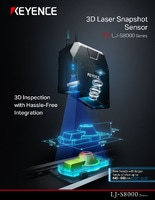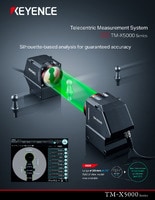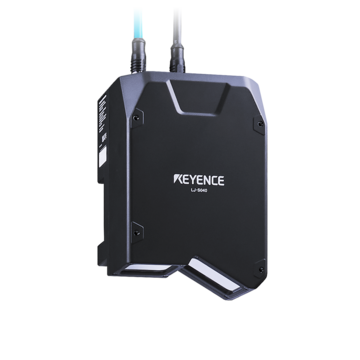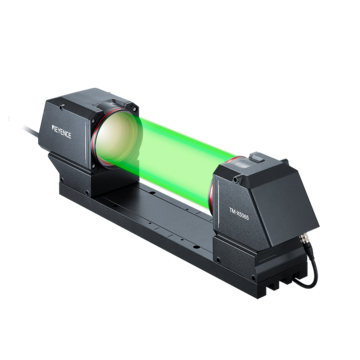Measurement Sensors
Dimension Measurement
Displacement Measurement
Cosmetic Defect Inspection Solutions for Enhanced Quality Control
Upholding high product quality standards is crucial for companies today. If any cosmetic flaws are present in a product, the modern-day customer will notice them. This means that everything from the functionality and safety to the packaging and appearance has to be flawless.
A big challenge for manufacturers is reducing surface defects like dents, scratches, or stains, which can occur during forming. The textured nature of many packaging materials makes early detection difficult, but these defects become more noticeable under specific lighting as production advances.
We’re here to provide you with more details.
Reach out today!

Why Choose Automated Cosmetic Defect Inspection?
Even minor packaging flaws can affect brand reputation and customer satisfaction, prompting a focus on advanced tech solutions for inspecting cosmetic packaging. One involves using laser profilers, laser displacement sensors, and snapshot sensors for automated cosmetic defect analysis.
Laser snapshot sensors, such as KEYENCE's LJ-S8000 Series, use advanced motor-driven scanning to eliminate external lighting and lensing needs. These sensors, designed for ultra-high-speed imaging in 0.2 seconds, efficiently capture 3D images of cosmetic packaging. This enables inline 100% inspections with minimal production time impact.
Benefits of Automated Cosmetic Defect Detection
Opting for automated cosmetic defect inspection offers unparalleled precision. Using non-contact measurement technology, laser profilers capture detailed 3D images of product surfaces, accurately identifying subtle defects like scratches, dents, and discoloration. This precision ensures only products meeting stringent quality standards reach the market, significantly reducing customer complaints and returns due to packaging flaws.
Automated cosmetic inspection precisely identifies defects with exceptional speed and efficiency. Using high-speed laser profilers, it examines hundreds of units in minutes, significantly reducing the time and labor of manual inspection, which allows resources to be reallocated to other tasks.
Another key advantage of automated cosmetic defect inspection is its ability to detect imperfections that are hard or difficult to see with the naked eye, like microscopic scratches or contaminants invisible under standard lighting. With laser profilers, these defects are efficiently identified and marked for further analysis, ensuring only flawless products reach the market.
Automated cosmetic defect inspection systems offer real-time data analysis, providing immediate feedback on production quality. This allows for early issue identification in the manufacturing process, enabling timely corrective actions. As a result, high product quality is maintained, and the risk of costly recalls or production delays is minimized.
Curious about our pricing?
Click here to find out more.

Key Industries Benefiting from Inspection Sensors
Inspection sensors are vital to various industries, providing precise and reliable data for quality control:
Manufacturing Industry
The manufacturing industry led in adopting inspection sensors for quality control, crucial for detecting defects during production to ensure superior products. They enable real-time monitoring, allowing prompt issue resolution. Used for assembly line inspections, part measurements, and surface defect detection, these sensors can spot the tiniest of imperfections, ensuring compliance with quality standards.
Logistics Industry
The logistics industry focuses on transporting goods and ensuring their optimal condition. Parcels can be inspected using sensors that make sure it is in good condition and not ripped or damaged, before it reaches its destination.
Food Processing
Food processing is a sensitive industry where safety and quality are paramount. Inspection sensors are used here to detect any damage or issues with packaging. It can also be used to ensure dimensions and other characteristics of the food. They can also be used to verify that all contents are present within their containers.
Common Cosmetic Defects and Their Impact on Quality
Cosmetic defects are a major concern in manufacturing, impacting both visual appeal and overall quality. Common issues include:
Scratches and Scuffs
Prevalent in industries like automotive and electronics, these arise from surface contact and can impair functionality, such as touch screen sensitivity.
Dents and Dings
Occur from impacts during manufacturing or transport, leading to potential safety risks and structural weaknesses, especially in precision industries like aerospace.
Impact on Quality
While often seen as minor, cosmetic defects can lead to customer complaints, returns, and a loss of brand trust, ultimately affecting sales and revenue. In safety-critical sectors, they pose significant risks to consumers.
Real-Time Cosmetic Defect Detection Using KEYENCE Measurement Sensors
KEYENCE's measurement sensors provide real-time defect detection in sectors like cosmetics, consumer goods, and automotive. Using advanced laser technology, they measure height, width, and angles to detect even the smallest product imperfections.
A key advantage of KEYENCE's LJ-X8000 Series measurement sensors is their non-contact operation, preventing damage or contamination. This is vital in industries like cosmetics, where product aesthetics are crucial for consumer satisfaction.
For reliable real-time cosmetic defect detection, choose KEYENCE's measurement sensors. Their high precision and non-contact technology ensure product quality and appearance. Contact us to enhance your industry and improve inspection processes.
Contact us to learn more about how our advanced technology can help take your business to the next level.
Contact Us
Related Products
Applications
Dimension Measurement
- Thickness and Width Measurement
- Step Height Measurement
- Inner and Outer Diameter Measurement
- Measuring Angles
- Meandering/Edge Measurement
Displacement Measurement
- Positioning and Stroke Length Measurement
- Vibration and Runout Measurement
- Deflection Measurement
- Measuring Eccentricity





